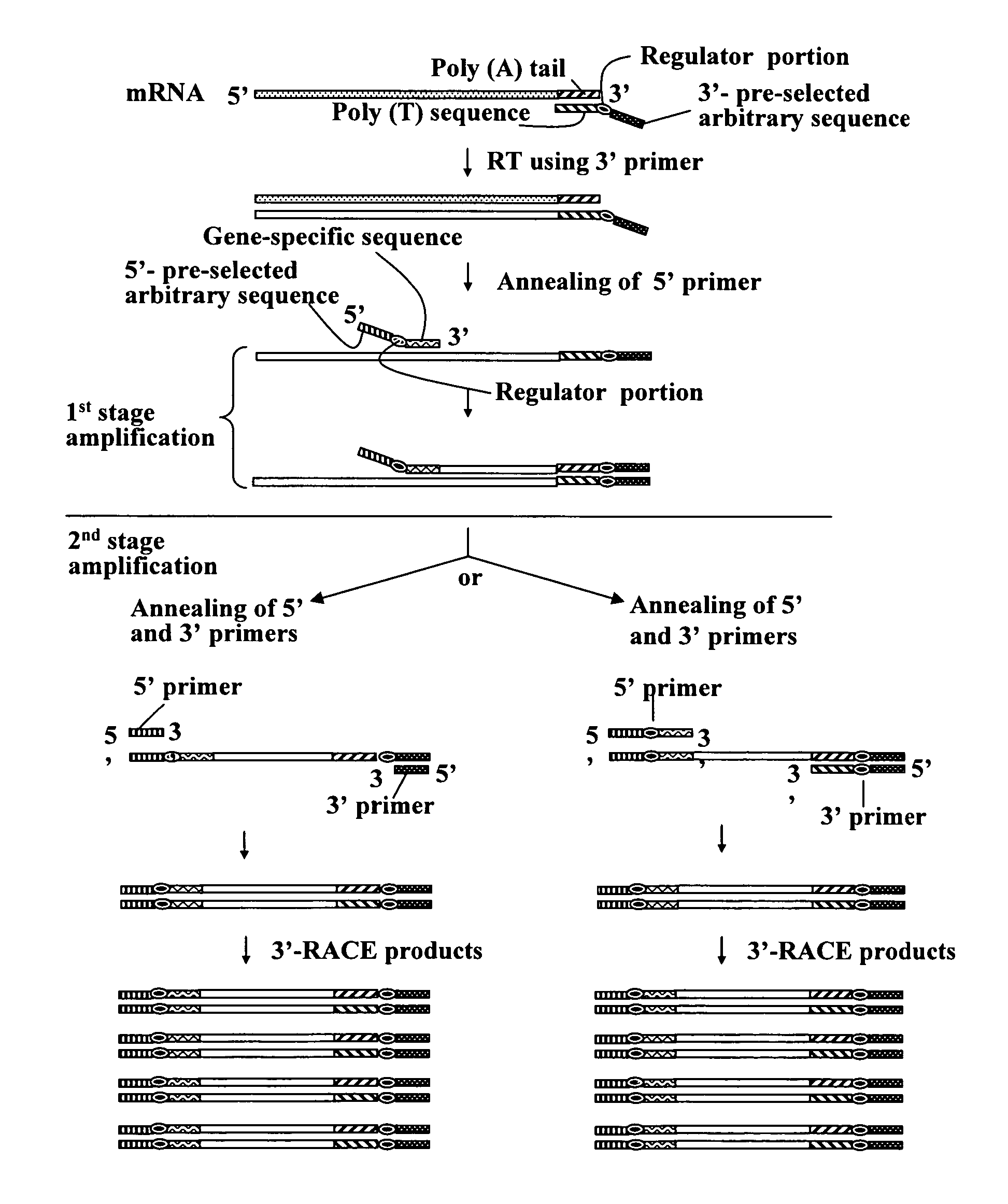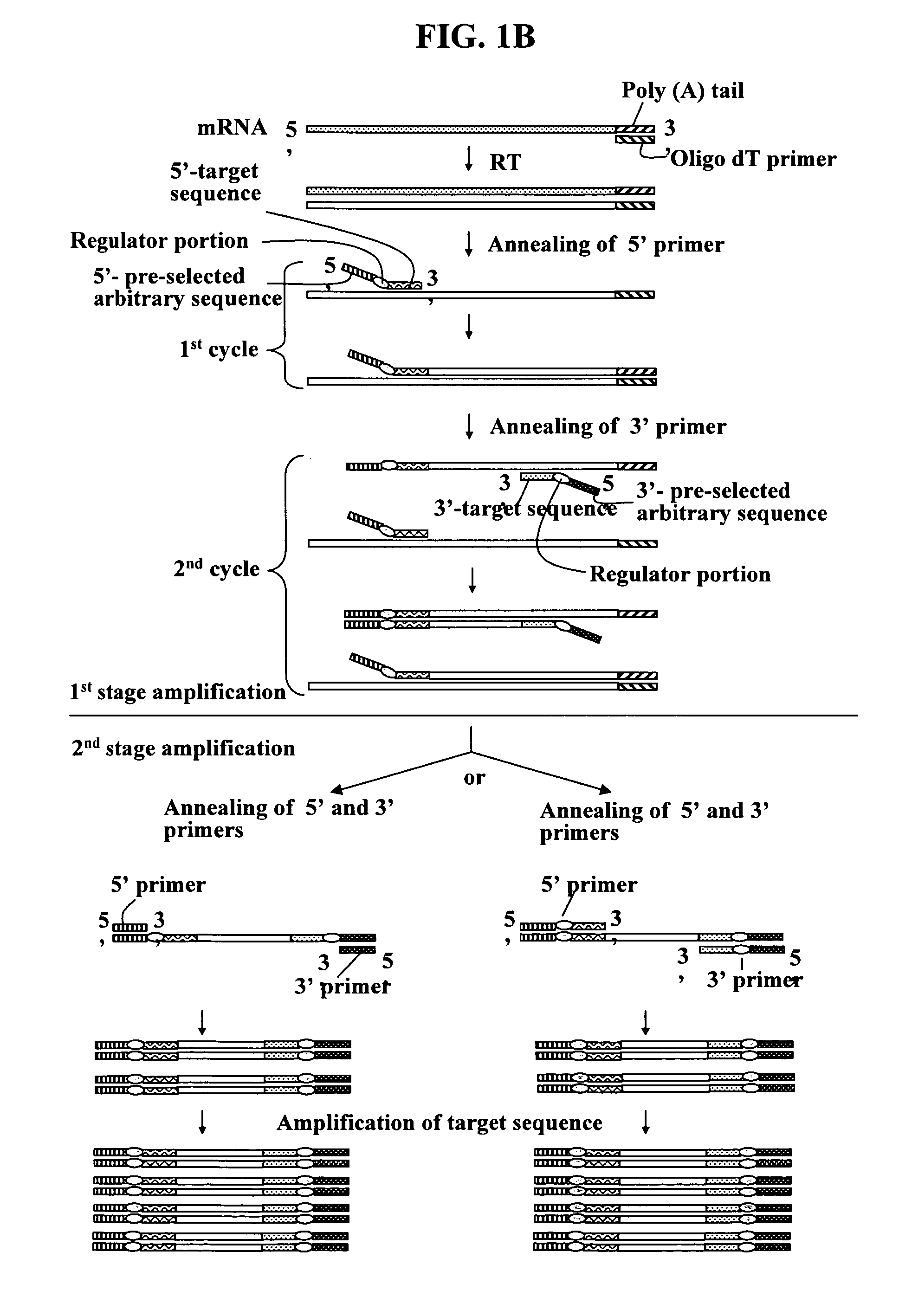Annealing control primer and its uses
a technology of control primer and annealing, applied in the field of annealing control primer, can solve the problems of increasing the amplification of non-target sequences, tedious testing of different additives, and not fundamentally addressing the problems arising from primers used in pcr amplification, such as non-specific products and high background
- Summary
- Abstract
- Description
- Claims
- Application Information
AI Technical Summary
Benefits of technology
Problems solved by technology
Method used
Image
Examples
example 1
Evaluation of Universal Base Effect in ACP
[0397]The effect of universal base residues positioned between the 3′- and 5′-end portions of ACP was evaluated by RT-PCR using mouse conceptus tissues.
[0398]Total RNA was isolated from the entire conceptuses of mouse strain ICR at the day of 4.5, 11.5 and 18.5 during gestation period using either Tri-reagent (Sigma), or the LiCl / Urea method (Hogan et al., 1994) as previously described (Chun et al., 1999; Hwang et al., 2000). Two individual experiments of cDNA amplifications using ACP were performed to examine the effect of universal base, particularly, deoxyinosine residues positioned between the 3′- and 5′-end portions of ACP as follows: A. The effect of deoxyinosine residues positioned between the 3′- and 5′-end portions of ACP in comparison with ACP and the conventional primer not containing a dexoyinosine group; B. The effect of deoxyinosine residues positioned between the 3′- and 5′-end portions of ACP in association with the alteratio...
example 2
Method for Amplifying a Target Nucleic Acid Sequence Using ACP
[0422]The ACP of the subject invention was applied to amplify target nucleotide sequences of mouse placenta-specific homeobox gene Esx1 cDNA. The process and results for the amplification of the target nucleotide sequences of Esx1 cDNA using ACPs are described herein. Total RNA (3 μg) obtained from mouse 18.5-day-old placenta was used as a starting material. First-strand cDNAs were prepared under the same conditions as used in the cDNA synthesis of Example 1, except that Oligo-dT15 was used as the first-strand cDNA synthesis primer.
[0423]
Oligo-dT155′-TTTTTTTTTTTTTTT-3′(SEQ ID NO:54)
[0424]The resultant first-strand cDNAs were used as templates to amplify target cDNA fragments of Esx1 using ACPs. These experiments conducted two stage PCR amplifications, which is one of unique features of the present invention.
[0425]The conventional primers of Esx1 used in the Example are:
[0426]
EsxN75′-GCCGGTTGCAGAAGCACC-3′;(SEQ ID NO:44)Esx...
example 3
Identification and Characterization of Differentially Expressed mRNAs During Mouse Embryonic Development Using ACP
[0450]The ACP of the subject invention has been applied to detect differentially expressed mRNAs in embryonic developments. Specifically, three different procedures and results using different stages of conceptus total RNAs as starting materials are described herein. The primers used in the subject invention are shown in Table 1.
A1. PROCEDURE 1
[0451]Step (1): First-Strand cDNA Synthesis
[0452]The first-strand cDNAs were prepared under the same conditions as used in the cDNA synthesis of Example 1 using the dT10-ACP1 or JYC5-T15-ACP as a cDNA synthesis primer. The resultant cDNAs were purified by a spin column (PCR purification Kit, QIAGEN) to remove primers, dNTP, and the above reagents. It is necessary to perform the purification step prior to the determination of the cDNAs concentration using the UV spectroscopy at an absorbance of 260 nm. The same amount of cDNAs from ...
PUM
| Property | Measurement | Unit |
|---|---|---|
| temperature | aaaaa | aaaaa |
| temperature | aaaaa | aaaaa |
| temperature | aaaaa | aaaaa |
Abstract
Description
Claims
Application Information
 Login to View More
Login to View More - R&D
- Intellectual Property
- Life Sciences
- Materials
- Tech Scout
- Unparalleled Data Quality
- Higher Quality Content
- 60% Fewer Hallucinations
Browse by: Latest US Patents, China's latest patents, Technical Efficacy Thesaurus, Application Domain, Technology Topic, Popular Technical Reports.
© 2025 PatSnap. All rights reserved.Legal|Privacy policy|Modern Slavery Act Transparency Statement|Sitemap|About US| Contact US: help@patsnap.com



